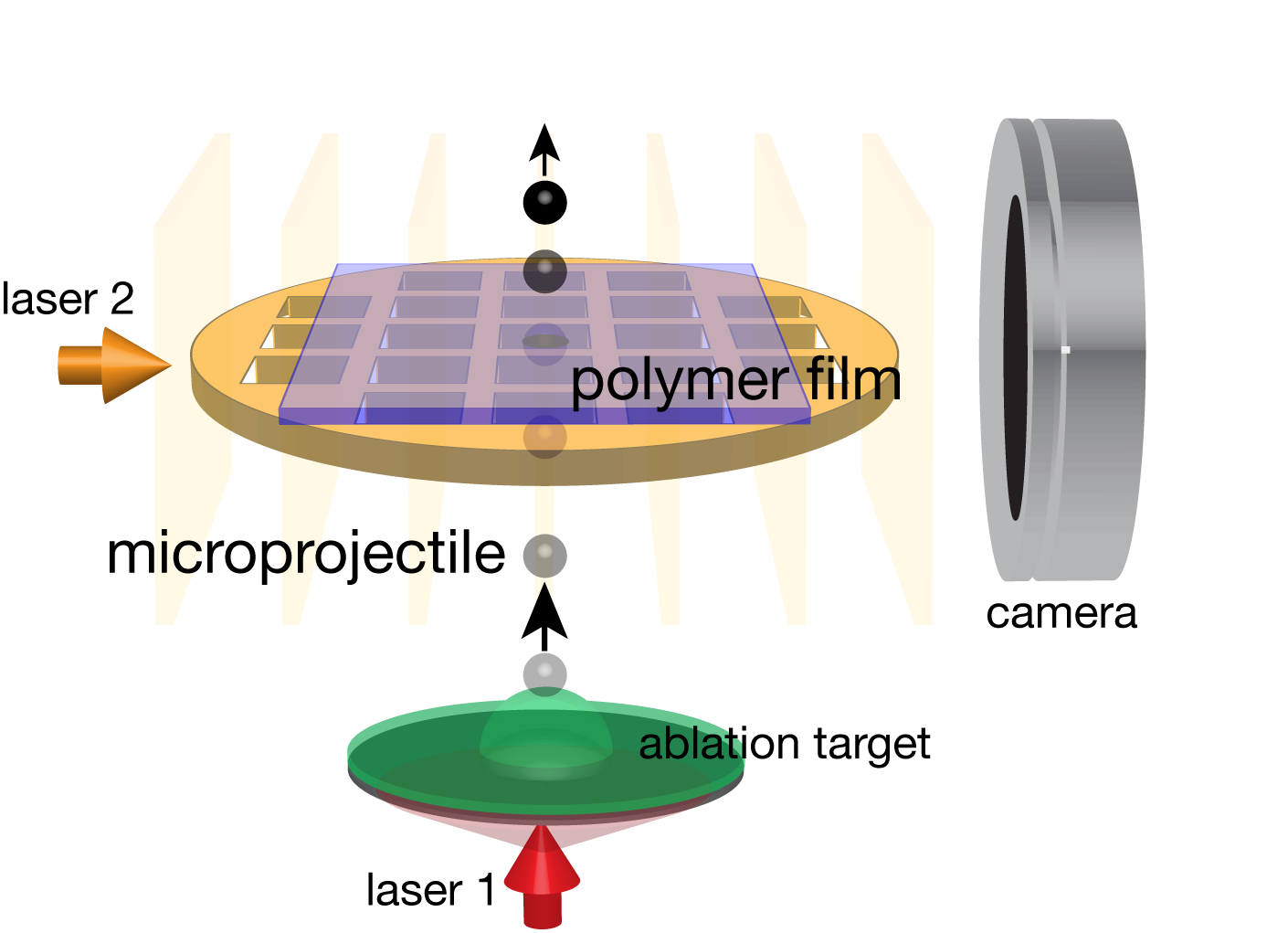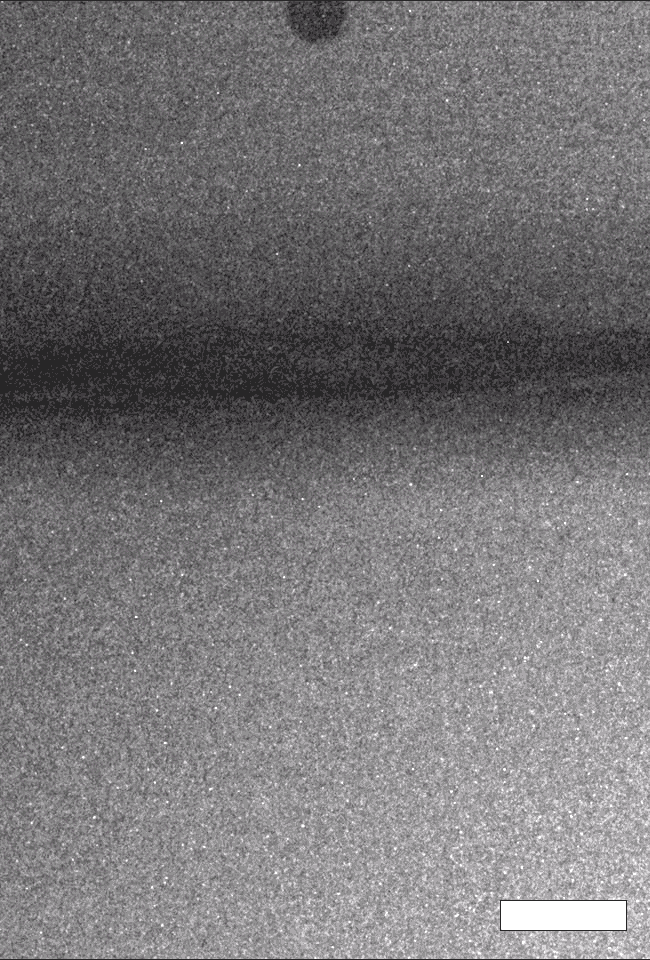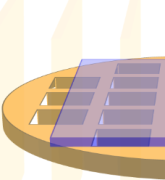日本語で読みたい方は、
google chromeで開いて、
画面上で右クリックをして
「日本語に翻訳」をクリックしてください
Using tiny laser-launched projectiles and troves of data, scientists can more quickly bridge the gap between a material’s microscopic properties and its real-world behavior.
July 03, 2023

NIST researchers designed a method that uses a high-intensity laser to blast microprojectiles at velocities close to the speed of sound at a target material, in this case a thin polymer film representing the puncture-resistant material to be tested. The test is called LIPIT, which stands for laser-induced projectile impact testing. Combining the test with analysis and scaling methods, scientists can discover new puncture-resistant materials.
Credit: E. Chan/NIST
A bullet piercing the protective armor of a first responder, a jellyfish stinging a swimmer, micrometeorites striking a satellite: High-speed projectiles that puncture materials show up in many forms. Researchers constantly aim to identify new materials that can better resist these high-speed puncture events, but it has been hard to connect the microscopic details of a promising new material to its actual behavior in real-world situations.
To address this issue, researchers at the National Institute of Standards and Technology (NIST) have designed a method that uses a high-intensity laser to blast microscale projectiles into a small sample at velocities that approach the speed of sound. The system analyzes the energy exchange between the particle and the sample of interest at the micro level then uses scaling methods to predict the puncture resistance of the material against larger energetic projectiles, such as bullets encountered in real-world situations. This new method, described in the journal ACS Applied Materials & Interfaces, reduces the need to perform a lengthy series of lab experiments with larger projectiles and bigger samples.
“When you’re investigating a new material for its protective applications, you don’t want to waste time, money and energy in scaling up your tests if the material doesn’t pan out. With our new method we can see earlier if it’s worth looking into a material for its protective properties,” said NIST chemist Katherine Evans.
During lab experiments, synthesizing small amounts of a new polymer — e.g., a few milligrams from glassware the size of a coffee cup — can be fairly routine. The challenge comes with scaling up to produce kilograms of material to be able to test its puncture resistance. For materials made from new synthetic polymers, scaling up to sufficient quantities is often not possible or practical.
“The problem with ballistic tests is that you must take two steps when making new materials. You need to synthesize a new polymer that you think will be better, and then scale it up to kilogram size. That is a big jump. The biggest accomplishment of this work is that we surprisingly show that the micro-ballistic tests can be scaled and linked to real-world large-scale tests,” said NIST materials research engineer Christopher Soles.
During the course of the study, researchers used their method to evaluate several materials, including a widely used compound for bulletproof glass, a novel nanocomposite, and the strong, all-carbon material known as graphene.
The test is called LIPIT, which stands for laser-induced projectile impact testing. It uses lasers to launch a microprojectile made of either silica or glass into a thin film of the material of interest. Through a process called laser ablation, the laser creates a high-pressure wave that propels the microprojectile material toward the sample.

LIPIT, which stands for laser-induced projectile impacting testing, uses tiny laser-launched microprojectiles aimed at a thin layer of polymer film.
Credit: E. Chan/NIST, modified by B. Hayes/NIST
The researchers first used the method to analyze a nanocomposite material known as polymer-grafted nanoparticle polymethacrylate (npPMA) composite. It consists of silica nanoparticles that could be useful in a wide range of applications including body armor. The laser propels microprojectiles at velocities from 100 to 400 meters per second at the target material and measures their impact using a video camera.
Researchers connected the results of the microprojectile test to what would happen in larger-scale impacts by combining the measurements they obtained on the npPMA with additional mathematical analysis while incorporating existing data on the material from the research literature. Since npPMA is a novel material and not easy to make, they expanded their analysis to also include a more commonly available compound known as polycarbonate, which is widely used as a bullet-resistant glass.
The combined approach of using literature results, dimensional analysis and LIPIT allowed researchers to show that the puncture resistance of a material is tied to the maximum stress a material can take before it breaks, called failure stress. This challenges the current understanding of ballistic performance, which is typically thought to be related to how pressure waves travel through the material.
Their new approach can identify the strength limits of a material, or how much stress and pressure it can handle, without having to directly measure these properties beforehand, which can help optimize which materials to choose in experiments. This then enabled them to explore materials such as graphene, which showed that multiple film layers of the material can be used in impact resistance applications similarly to high-performance polymers.
“This new paradigm gives us a new experimental tool to evaluate the hype of some of these graphene and other 2D materials that are predicted to have excellent ballistic properties. We have the potential to experimentally verify if these materials would outperform classic ballistic resistant materials like polycarbonates, even without scaling up the synthesis of novel 2D materials, which would be prohibitively costly,” said Soles.
Their method could help identify new materials for many applications such as additive manufacturing, spacecraft protection, better protective gear against animal bites, and even drug delivery. Researchers are looking into developing needle-free injections in which a high-speed stream of fluid known as a liquid jet punctures the skin. While many applications aim to avoid punctures, LIPIT can provide insights in this case on how to most effectively penetrate the skin using liquid jets as projectiles.
As for next steps, the researchers are pursuing several avenues. They plan to evaluate the ballistic resistance of additional novel materials and look at the different types and configurations. They will also vary the size of the microprojectiles and expand their velocity range.
NIST researchers are also looking to connect LIPIT’s experimental results to two types of simulations. One is finite element analysis (FEA), in which the object of interest is modeled as a group of simpler pieces that are interconnected. FEA is traditionally used to simulate the mechanical deformation of the entire sample. Sometimes researchers can perform an FEA simulation faster than a lab experiment. However, in the end the simulation has to agree with experimental data on the actual material, said NIST materials science engineer Edwin Chan.
The second simulation approach is called molecular dynamics (MD). This is a kind of simulation that is much smaller in scale, looking at the behavior at the molecular level of materials such as polymers. MD can explore how polymer components such as molecular chains deform after a projectile strikes the material.
“Since we don’t have the ability to directly see what the polymer chains are doing, MD is insightful as it gives us a better idea on why certain polymers are better for impact resistance,” said Chan.
The researchers expect their methodology to open up many new possibilities for investigating the behavior of materials.
“With this approach, we can ask, ‘What other things in the system can we change, or how can we improve a material for specific applications?’ Instead of changing the composition of a material, you could change its geometry. Or you can study a material from nature and see how it behaves,” said Evans.
Paper: Katherine Evans, Shawn Chen, Amanda Souna, Stephan Stranick, Christopher Soles and Edwin Chan. The Projectile Perforation Resistance of Materials: Scaling the Impact Resistance of Thin Films to Macroscale Materials. ACS Applied Materials & Interfaces. Published online June 29, 2023.DOI: 10.1021/acsami.3c05130
出典:
https://www.nist.gov/news-events/news/2023/07/new-laser-based-method-could-help-scientists-discover-new-puncture
In case of addition or removal of the article, please contact us as below:
info@symphotony.com
この情報へのアクセスはメンバーに限定されています。ログインしてください。メンバー登録は下記リンクをクリックしてください。

